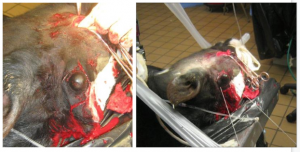FA youngstock processing
How to – Surgical (cosmetic) dehorning
Indications
Surgical dehorning is most commonly indicated in adult goats due to trauma (horn breakage), scurs or missed dehorning. It is referred to as “cosmetic” but may or may not be cosmetic. Adult cattle may be surgically dehorned if not dehorned at an earlier age; however, horn tipping is preferable.
Relevant anatomy
The skin around the horn is tight; this procedure will require tension relief techniques.
The horn is attached to the bone and the procedure will open the frontal sinus.
In goats, the horn scent glands should also be removed
Preoperative management
Food restrictions:
- For goats, the procedure should be performed under general anesthesia. Food should be restricted for 24 hours.
- In adult cattle, local blocks and a chute with a head restraint are typically sufficient. Sedation may be indicated, as well.
NSAIDs/analgesics: Patients should be premedicated with NSAIDs.
Antibiotics: Preoperative antibiotics are recommended as this is a contaminated procedure due to the involvement of the airway.
Tetanus prophylaxis is recommended, particularly in goats.
Local blocks:
The cornual nerve should be blocked in cattle.
- Palpate the temporal ridge.
- Inject local anesthetic below the ridge, halfway between the lateral canthus of the eye and the horn.
- Inject local anesthetic caudal and lateral to the horn bud to ensure all branches are blocked.

Both the cornual and infratrochlear nerves should be blocked in goats. A ring block around the horn can also be helpful.

OVC has developed an easier method of local anesthesia – they inject lidocaine subcutaneously under the horn bud vs trying to find the nerves.
Position/preparation:
Cattle are maintained in a standing position. Goats can be placed in lateral or sternal recumbency. Clip and prep a large area (will be needed for closure).
Surgery Supplies:
- scalpel and blade
- gigli wire, wire cutters and handles (keep the gigli wire at least twice the length of your arm)
- hemostats
- mayo scissors
- rongeurs or Barnes dehorners
- saline or LRS lavage solution
- suture (2-0 or 0 nonabsorbable suture)
- needle holders
- bandage material
Surgical procedure
- A fusiform incision is made around the horn, following the frontal crest and as close to the horn as possible. The incision is deepened through the periosteum to bone.

- The edges of the incision are undermined using sharp dissection to allow seating of the gigli wire.
- The gigli wire is used to remove the horn, removing as much bone as possible to permit wound closure
- Bleeding is controlled by pulling any visible arteries with the hemostat
- The wound is flushed and closed
- Closure may require undermining, mesh incisions and/or tension relieving patterns. More bone may be removed using the rongeurs or Barnes (in cattle).
- If closure isn’t possible, bandaging is needed to protect the sinus
Postoperative care
- Bandage changes when slipping, wet or dirty, if applicable. Bandaging should continue until a scab has formed. Feed on the ground until the sinus is covered over (prevent hay being pulled into the sinus from an overhead feeder). Fly repellant should also be used.
- Suture removal in 10-14 days
- NSAIDs can be continued for 3 days.
Complications
- Sinusitis
- Lack of closure (will close over the next 4-6 weeks)
Videos
Using a Barnes dehorning to remove the horn in an anesthetized calf. Youtube video
Barnes dehorners should be used very cautiously in the goats as it can readily remove too much skull. Youtube video
Resources
Bovine Surgery of the Skin, 2008 VCNA

